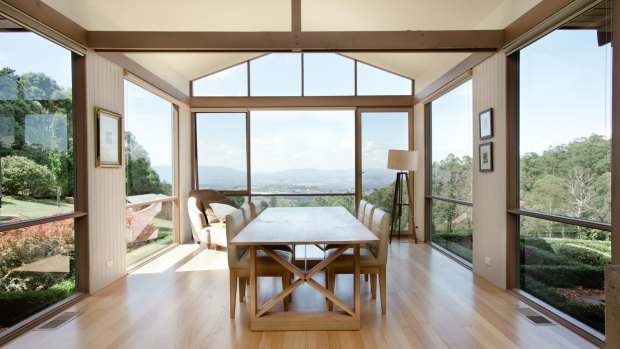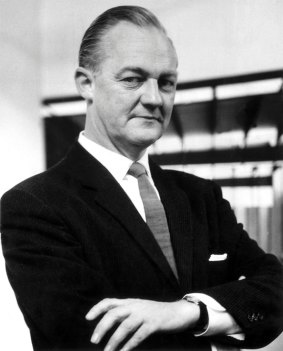This was published 6 years ago
Architect Robin Boyd: The Melbourne man who has become a tourist attraction
By Paul Chai

Moorabinda Lodge with sweeping views of the Yarra Valley was designed for then owners the Bankins in 1962.
Melbourne architect Robin Boyd was always more than just a designer of houses. The design evangelist was a cultural commentator, a filmmaker and a co-host of legendary cocktail parties where prime ministers rubbed shoulders with artists and opera singers. Now, posthumously, Boyd has added another string to his bow: he is a tourist attraction.
With mid-century modernism back in style from tiki bars to Airstream caravans, many travellers are now adding Boyd's unique buildings to their tourism itineraries, travelling to stay, or just to admire this architect who was ahead of his time.
In Boyd's searing critique of the 1950s and '60s obsession with ornament over practicality, The Australian Ugliness, he argued that Australia was slavishly following the United States rather than creating original, innovative designs that suited our country. In his fierce takedown of poor design he was staking his claim as a design nationalist, arguing for a national approach to buildings and design, one that reflected who we were as a people.

Australian architect Robin Boyd took a national approach to buildings and design.
And Boyd walked the walk. I am sitting in the dining room of his one-time family home at 290 Walsh Street in the southern suburb of South Yarra, designed in 1957 and now home to the Boyd Foundation. Behind a non-descript fence with a flamboyant red door Walsh Street is designed to lead you in to the big reveal, an upper living space designed for the view, looking out on to an internal courtyard (decades before they would become de rigueur) and a second wing of the house that was for Boyd's children.
Sitting with me is Boyd Foundation director of programming Tony Lee who is explaining how Boyd designed the open kitchen so that his wife, Patricia, would not miss out on the conversations, and how the distinctive sloping roof was years ahead of its time. Boyd's home embodies the principals of The Australian Ugliness, how he hated homes built in the centre of a block of land and how a building must be site specific.
To illustrate, Lee compares Boyd to Sydney's mid-century star Harry Seidler. "You know Harry Seidler's Rose Seidler House in Sydney?" Lee asks. "You could physically pick that up and pop it in Zurich or LA and it would look totally fine, you could not take this house off this site, it wouldn't work, it was designed specifically for the views, for the orientation of the site, it is very site specific as were all Robin's projects. Harry Seidler was an international modernist, he did the same thing, his Sydney towers look the same as his Melbourne Towers. Robin was very localised but with an incredible awareness of what was going on around the world."
If Boyd designed your home his technique was to spend time with the family, eat dinner, have a drink, then on the final meeting he would present a design based on his observations of how the family used the space. Lee says that a common response to the final design was: "it was nothing like we expected but exactly what we wanted".
"With Harry you would get a house that everyone will applaud you for building but go to Boyd you will get the house you always dreamt of living in," Lee says of the rivalry. "Harry was formulaic and you had to learn to live in a Harry Seidler house and adapt the way you live to suit the house but Robin was a very empathetic person, a strong humanist, so he studied people, and understood how they lived."
This intuitive design led Boyd to split Walsh Street in two, based on a frustrating day trying to work from home with the kids making noise. In a stroke of a pen they had their own "children's pavilion" but one that could be observed from Robin and Patricia's party wing. The house now is a mid-century time capsule, full of retro furniture, '50s artworks and even the Boyd family's original library. It is a flexible, fascinating space that is only really dated by the interior furnishings.
On the other side of the Yarra River, in the inner-city suburb of Carlton you can dine in one of Boyd's earliest creations, and what is arguably one of Australia's first small bars. Jimmy Watson's restaurant and wine bar has been on this site since 1935, a family-run wine business that lends its name to one of the country's most prestigious wine trophies, the Jimmy Watson Trophy.
When Watson wanted to overhaul his wine bar he turned to a regular drinker, architect Roy Grounds, but Grounds was busy with a small project knows as the Arts Centre in the city. He recommended his partner, a young Robin Boyd who had a playful take on the refit. Jimmy Watson's is comprised of three terrace houses and has the address of 333 Lygon Street, so Boyd reflected this in the design.
"It is a very clever building that is very much ahead of its time in terms of heritage and streetscape," says Lee. "Robin wasn't interested in doing a twee reproduction so he took a lot of the windows out and if you look at the building when you come down the street it still sits very comfortably in Lygon Street and you have this incredible play: the address is 333 Lygon Street, you have three terrace house, so you get three entry windows, each set of three windows consists of three windows, so it's quite quirky in that respect."
Alan Watson, Jimmy's son who oversaw much of the Boyd work, says the architect was a kind and gentle man, who was open to suggestion but he loved his original concept. "It was very different but I thought it was a great idea," says Watson. "Quite a few architects now come in and have a look, I think it's the best example of his work."
Heading out the Yarra Ranges you can spend the night in a Boyd house at the beautifully positioned Moorabinda Lodge. This site, with sweeping views of the Yarra Valley was designed for then owners the Bankins in 1962. The home is totally in thrall to its valley view, the landscapes dominate the bedrooms, the kitchen and the dining room; the mood of the building changes with the clouds and the sun and like Walsh Street you can't imagine the home in any other location. The lodge uses aspects of Japanese architecture but some recent renovations make it a controversial property in the eyes of the foundation.
Other Boyds can be observed from the roadside. There is the Domain Park set of apartments just around the corner from the foundation, the John Batman Motor Inn on the corner of Queens Road and Lorne Street – overlooking Albert Park lake that is now public housing – and the Tower Hill visitors' centre in Western Victoria whose roof mimics the undulating shape of the surrounding hills. But one of the best ways to be a Boyd tourist is to grab a cocktail at Walsh Street, though prime ministers and opera singers are no longer guaranteed.
"We have taken the approach that we don't open the house like a National Trust house because that is very boring," says Lee. "You come to this house for events and to do things in the house, you can come to the house for drinks as Robin and Patricia intended. An invitation to dine at Walsh Street was one of the hottest tickets in Melbourne. What we try to do is build on that, so when you come to the house you have a good time but you also learn something."
FIVE MORE INFLUENTIAL MELBOURNE ARCHITECTS
ROY GROUNDS
Roy Grounds was not only Boyd's mentor and business partner – in Grounds, Romberg and Boyd – but was a renowned modernist in his own right. Grounds is best known for his work on the National Gallery of Victoria and the Arts Centre project on the banks of the Yarra River. Other works include the Wrest Point Casino in Hobart and a family home for the Myers in Toorak.
WALTER BURLEY GRIFFIN
Best known as the architect of the city of Canberra, Walter Burley Griffin was born in Chicago and lived for a while in Melbourne. There he was involved in the design of the city's Capitol Theatre that opened in 1924. Boyd was a fan of Griffin describing the Capitol as "the best cinema that was ever built or is ever likely to be built".
JOSEPH REID
One of Melbourne's earliest architect rock stars was Joseph Reed whose work can be seen in the Melbourne CBD at spots like the Gothic-inspired Scots Church and St Michael's Church on Collins Street. Reed established his practice in 1853 and soon after won a design competition for the State Library of Victoria and then designed the Collins Street Baptist Church that looks like a Greek Temple with tall Corinthian columns.
MARCUS BARLOW
Hometown hero Barlow is responsible for one of the CBD's most distinctive facades in the Manchester Unity building, an art deco masterpiece with a moulded terracotta facade inspired by the Chicago Tribune building in the US. Do yourself a favour and go into the foyer to see the ornate metal lift doors and deco artworks set into the walls.
FENDER KATSALIDAS ARCHITECTS (FKA)
The Eureka Building is a Melbourne skyscraper that has put these modern architects in the spotlight thanks to the thoughtful design elements. FKA were inspired by the Eureka rebellion with the top 10 floors of gold representing the gold rush, the red strip representing the spilled blood of the rebellion and the blue and white colours standing in for the Eureka flag.
TRIP NOTES
STAY
Moorabinda Lodge sleeps eight and is priced according to the number of guests, prices start at $360 for two guests ($720, two nights) and $460 for four guests ($920 two nights). Bookings are through Valley Ranges Getaways; 129 Olinda-Monbulk Road; valleyrangesgetaways.com.au
EAT
Grab dinner at a Boyd property, and Melbourne institution, when you visit Jimmy Watson's in Carlton. You can dine in the formal dining room at the front or sit outside in the non-Boyd designed courtyard; 333 Lygon Street, Carlton; jimmywatsons.com
SEE and DO
The Boyd Foundation opens Walsh Street for a variety of special events, generally involving cocktails or a lecture. There is the Open Days program, the Speaker Series of public lectures and Design Studios and Movie Nights. For the regularly updated list of offering, see robinboyd.org.au
Robin Boyd's last masterplan before his death was at Mitchelton Winery an hour north of Melbourne that recently got a new boutique hotel. The foundation does not consider this property a Boyd work, but he is credited with the idea of a "destination winery" that included a cellar door, function room and hotel (originally an on-trend Travelodge); see mitchelton.com.au
MELTours Melbourne Walking Tours offers a range of guided walks including a city architecture tour that will teach you to look up and see some of the city's amazing buildings; meltours.com.au
Sign up for the Traveller Deals newsletter
Get exclusive travel deals delivered straight to your inbox. Sign up now.